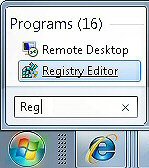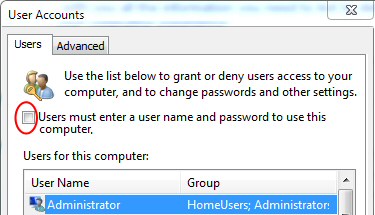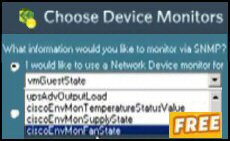Windows 7 Auto Login with AutoAdminLogon
The idea behind the Windows 7 Auto Login is that a user(name) can logon at a computer without having to type their password. A typical scenario would be a test machine on a private network. With Auto Login enabled, when you restart the machine it automatically logs on a named user. The trick, which also its liability, is to use regedit to set a value for DefaultPassword in the registry.
Topics for Windows 7 Auto Login
- Instructions to Enable Auto Login with Regedit
- Key Learning Points
- Auto Login for Windows 7 Home Editions
- A real-life Story Starring AutoAdminLogon
♦
Instructions to Enable Auto Login with Regedit
- Launch Regedit. (See more details on starting regedit)
- Navigate to:
HKLM\Software\Microsoft\Windows NT\CurrentVersion\winlogon
Set: AutoAdminLogon = 1 (one means on, zero means off) - Tip: Try Regedit’s ‘Find’: AutoAdminLogon.
- Crucial Point set the Administrator’s password.
- Create a new String Value called DefaultPassword
Set: DefaultPassword = "P@ssw0rd". - Check for the existence of a REG_SZ called DefaultUserName. The value should reflect the user who you wish to logon automatically. If this value does not exist, then right-click in the right pane, New, REG_SZ, name it, DefaultUserName. Set the string value to the required UserName.
- Optional Item: If your Windows 7 Machine has joined a domain, then create a String Value called DefaultDomainName.
Set: DefaultDomainName = "OnlyYouKnowDomain"
Here is a summary of the four key registry settings to enable Auto Login
AutoAdminLogon = "1" Enabled (To disable user Auto Login set to zero)
DefaultUserName = "xxx"
DefaultPassword = "xxxx0xxxx"
DefaultDomainName = "xxx.xxx". Definitely needed in a domain situation.
Guy Recommends: A Free Trial of the Network Performance Monitor (NPM) v11.5
v11.5
SolarWinds’ Orion performance monitor will help you discover what’s happening on your network. This utility will also guide you through troubleshooting; the dashboard will indicate whether the root cause is a broken link, faulty equipment or resource overload.
What I like best is the way NPM suggests solutions to network problems. Its also has the ability to monitor the health of individual VMware virtual machines. If you are interested in troubleshooting, and creating network maps, then I recommend that you try NPM now.
Download a free trial of Solarwinds’ Network Performance Monitor
Disable Auto Login in Registry
It’s easy to disable Auto Login with regedit, you just need to find, then change AutoAdminLogon from 1 to zero. You can leave the other settings, especially if you change your mind later.
Key Learning Points
- When you set a user’s Auto Login with regedit, do you find the AutoAdminLogon value in HKCU** or HKLM?
Answer: HKLM - Do you have to add a value, or modify an existing setting?
Answer: Modify 0 (Disabled) –> 1 (Enabled). - Is it a String Value or a DWORD?
Answer: These are all REG_SZ (String value). - Do you need to Restart, or merely Logoff / Logon?
Answer: Restart - Extra Information: To enable Auto Login with regedit you also need to create a REG_SZ called, DefaultPassword, and possibly another called DefaultDomainName.
- If you ever need to breakout of AutoAdminLogon, hold down the shift key as Windows 7 initializes and the user logs on. What the shift key does is enable you to logon as a different user.
Auto Login for Windows 7 Home Editions
I have been using AutoAdminLogon since NT 3.5, however, in Windows 7 Home editions there is a much easier alternative, namely tick: ‘Users must enter a user name and password’.
Unlike Vista, in Windows 7 you need to launch an native, but hidden applet called NetPlwiz. Once the User Accounts interface appears select the user who you want Auto Logon, now remove the tick in the checkbox.
‘Users must enter a user name and password’.
Click OK
All you need to do next is type the password twice in the, ‘Automatically Log On’ dialog box. See screenshot. Once you restart Windows 7, it will logon that user automatically.
Double-check the logic of what you are ticking. Also, when you set a registry value to one or zero, read the value carefully. Half of all people who write and say ‘Guy that tweak did not work’, have not understood the logic, double negatives are a particular source of errors.
Before you try the above configuration, note: I did not, repeat, not find this setting in a machine which had joined an Active Directory domain.
Just out of interest I would check the registry to see how AutoAdminLogon has been configured (Regedit, Edit menu find AutoAdminLogon).
Guy Recommends SolarWinds’ Free Network Monitor
Thus utility makes it easy to check the health of a router or firewall. Check the real-time performance, and availability statistics, for any device on your network. Get started with an extensive collection of "out-of-the-box" monitors for popular network devices. Give Network Monitor a whirl – it’s free. Download your free Network Device Monitor
If you need more comprehensive network analysis software:
Download a free trial of NPM (Network Performance Monitor)
A Real-life Story Starring AutoAdminLogon
Guy’s 3rd Law of computing states: ‘The more security that you have, then the more work there will be for you’. This law certainly applies to complex passwords, where you need to remember a combination of uppercase, lowercase, number and squiggles (non-alphanumeric characters).
Let me give you an example of why I like the registry setting AutoAdminLogon, I was training a new Windows 7 course containing two delegates from hell. The other ingredient was a new technician, who installed the default American keyboard layout; even though we were in London England, where naturally our keyboards had the UK layout.
The course started with the delegates logging on to their Windows 7 machines as Administrator with the password of P@ssw0rd. Have you guessed the problem? The @ was not on the keyboard where the delegates and I thought it would be, namely above the comma. Thanks to the USA / UK mixed setup, the @ was above the numeric 2.
Most of the first session was spent getting the 8 delegates just to logon. For the second exercise, they had to join a domain – that took the rest of the morning because after the restart they had to grapple with the complex password – again.
Over lunchtime I edited the registry, my aim was to activate AutoAdminLogon and thus configure an automatic logon without delegate input. You can see above how I achieved this in: Instructions for Setting AutoAdminLogon.
Creating a .Reg File
For my solution to work, I needed the same settings on all 8 machines. Thus from my machine I exported the HKLM\Software\Microsoft\Windows NT\CurrentVersion\winlogon branch of the registry into a .reg file, which I then imported to each of the delegates machines. No more problems with logging on after that. Training is the classic place to try these naughty but nice tricks; another scenario for AutoAdminLogon is for test machines not connected to a production network. Example AutoAdminLogon .reg file.
Summary of Logon Window 7 Auto Login
Thanks to regedit, Auto Login can be enabled so that you can logon automatically without having to enter a password. Such configurations are most useful for testing. You could also justify editing the registry, and setting AutoAdminLogon on a machine in a room that is physically secure, or a place where only you have access.
If you like this page then please share it with your friends
More Windows 7 Registry Tweaks
- Gpedit – Local Group Policy Editor
- Editing the Windows 7 Registry with PowerShell
- PaintDesktopVersion (Build Number)
- Change the Name of a Windows 7 Computer
with LocalizedString - Hide User From Welcome Screen
- RegisteredOwner – Windows 7 Registry Hack
- NoDriveTypeAutoRun
- Delete Roaming Profile Cache
- Windows 7 .Reg Files Examples
- Performance Monitoring



